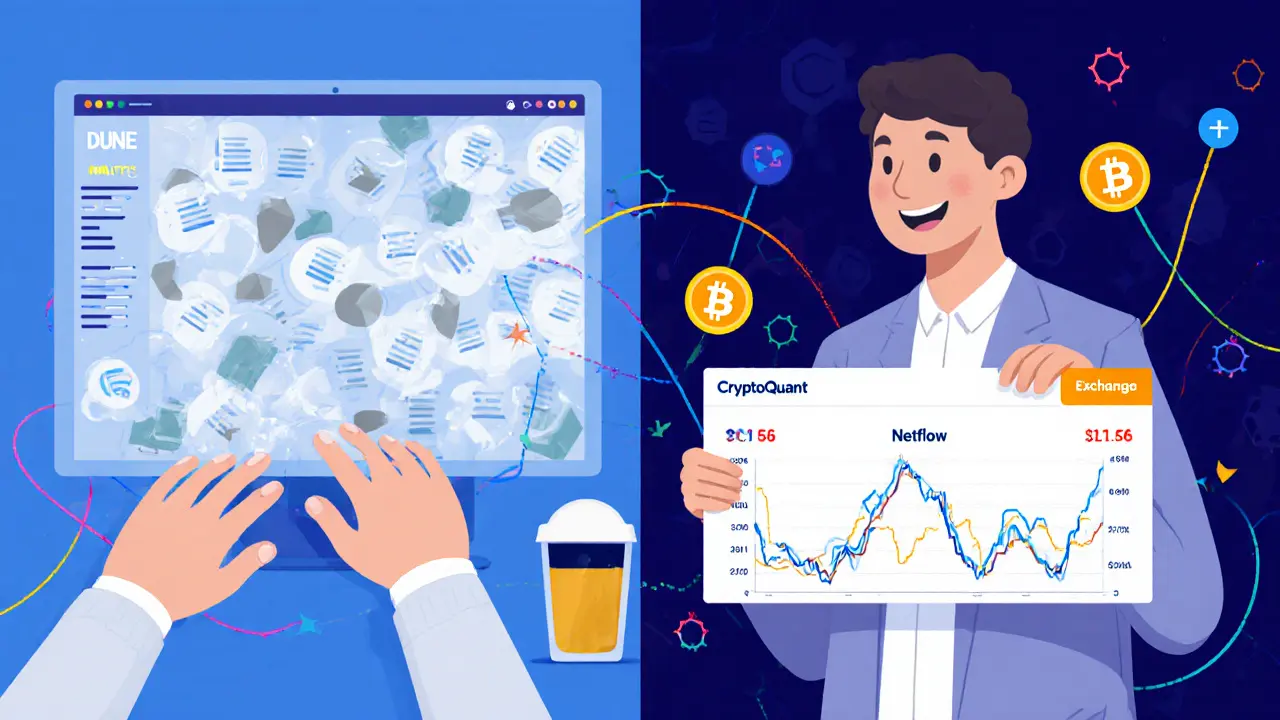On-Chain Analysis Tool Selector
Find your perfect on-chain analysis tool
Based on your trading style, goals, and experience level, we'll recommend the best tool for you.
Key takeaway: Only pay for tools you'll use weekly. Start with one core tool and one complementary one.
On-chain analysis isn’t just for tech experts anymore. If you’re trading Bitcoin, Ethereum, or any major crypto asset, ignoring what’s happening on the blockchain is like driving blindfolded. You can see price charts all day, but without knowing who’s buying, who’s selling, and where the real money is moving, you’re guessing. On-chain tools cut through the noise. They show you actual wallet movements, exchange inflows, whale activity, and profit-taking patterns - all pulled straight from the blockchain. This isn’t theory. It’s data that’s been proven to predict price moves before they happen.
What Exactly Is On-Chain Analysis?
On-chain analysis means looking at the raw data recorded on a blockchain - every transaction, every wallet interaction, every smart contract call. It’s not about news headlines or Twitter trends. It’s about what people are actually doing with their coins. For example, if a large wallet that hasn’t moved ETH in three years suddenly sends 5,000 ETH to an exchange, that’s a signal. It might mean they’re cashing out. If hundreds of small wallets start buying Bitcoin after a dip, that’s accumulation. These patterns don’t lie.
The tools that make this possible didn’t exist 10 years ago. Early blockchain explorers like Etherscan just showed transactions. Today’s platforms turn that raw data into charts, alerts, and predictive scores. They track over a billion transactions daily across dozens of blockchains. Some even use AI to spot patterns humans miss. The market for this tech is exploding - worth $1.27 billion in 2023 and expected to hit nearly $10 billion by 2030. That’s not hype. It’s demand from hedge funds, exchanges, and regulators who need to understand crypto movements in real time.
Top Platforms Compared: Who Does What Best?
Not all on-chain tools are made the same. Some are built for institutions. Others are made for retail traders. Here’s how the leaders stack up based on real usage and performance data from 2024.
| Platform | Best For | Key Metrics | Users | Price Tier |
|---|---|---|---|---|
| Glassnode A blockchain analytics platform offering over 500 on-chain metrics for institutional investors | Market cycles, long-term trends | MVRV-Z Score, NUPL, Active Addresses | Professional traders, hedge funds | $99+/month |
| Nansen A blockchain intelligence platform that labels wallets and tracks "Smart Money" movements | Whale tracking, early signals | Smart Money Alerts, Labeled Wallets (180M+) | Institutional investors, retail pros | $1,499/month (Pro) |
| Dune Analytics A SQL-based platform for creating custom dashboards on blockchain data | Custom analysis, developers | Custom queries, 250K+ public dashboards | Developers, researchers, advanced users | Free tier available |
| CryptoQuant A platform focused on exchange flow and miner activity metrics | Exchange inflows, short-term price moves | Exchange Netflow, Miner Balance Change | Day traders, arbitrageurs | $49+/month |
| Chainalysis A compliance and forensic platform used by governments and exchanges | Regulatory reporting, fraud detection | Entity Clustering, Transaction Tracing | Exchanges, law enforcement | $50,000+/year (enterprise only) |
Let’s break this down. If you care about whether Bitcoin is overbought or undervalued, Glassnode’s MVRV-Z Score is your go-to. It compares current market value to the cost basis of all coins - a proven indicator of market tops and bottoms. Over 87% of professional traders use it to time entries and exits.
If you want to know what the smartest investors are doing - the ones who bought Bitcoin at $3,000 and held through every crash - Nansen is unmatched. It labels wallets: “VC,” “Exchange,” “Whale,” “DAO.” When a VC wallet labeled as "a16z" buys a new token, you see it in real time. One Reddit user caught a $SUI pump four hours before it jumped 120% because Nansen flagged the VC’s purchase.
Dune Analytics is the wild card. It doesn’t give you pre-built charts. It gives you a SQL engine. You write queries like “Show me all wallets that sent more than 10 ETH to Uniswap in the last 7 days.” There are over 250,000 public dashboards you can copy and tweak. It’s free to start. But if you don’t know SQL, it’ll take you weeks to get good. Most users spend 10-15 hours learning before they get useful results.

Who Should Use Which Tool?
Not everyone needs the same thing. Your choice depends on your goals.
- For retail traders who want alerts: Start with CryptoQuant. It shows you when big money is flowing into or out of exchanges - a leading signal for short-term price moves. Their exchange netflow data has 89% accuracy in predicting Bitcoin’s direction within 48 hours, according to their own backtests.
- For long-term investors: Glassnode is your best friend. Their NUPL (Net Unrealized Profit/Loss) metric tells you if the market is in greed or fear territory. When NUPL hits 0.8, it’s historically been a top. When it drops below 0.2, it’s often a bottom.
- For serious traders tracking whales: Nansen is worth the $1,500/month. You’ll see when institutional wallets move $10M+ in a single transaction. That’s not noise - that’s intent.
- For developers and researchers: Dune is the only tool that lets you build your own models. Want to track how many new wallets are created daily on Arbitrum? You can do it. No one else gives you that freedom.
- For exchanges or compliance teams: Chainalysis is the industry standard. But you’ll need a $50,000/year budget. No self-serve option. No free trial. If you’re not a company, skip it.
What’s New in 2025?
The game is changing fast. In 2024, AI started making real impacts. Nansen’s Cross-Chain Tracker now analyzes Bitcoin, Ethereum, Solana, and 12 other chains in seconds - not hours. Glassnode’s new On-Chain Health Dashboard combines 12 metrics into one score that matches market sentiment with 92% accuracy.
Arkham Intelligence launched an AI assistant in November 2024 that answers natural language questions like, “Which wallets are buying $PEPE most aggressively?” It gets 85% of the answers right. That’s a game-changer for people who don’t want to learn SQL or interpret charts.
But there’s a catch. These tools are getting more powerful - and more expensive. Nansen’s Pro plan jumped to $1,499/month. Arkham’s minimum is $299/month. Dune’s free tier now limits you to 20 queries per hour. If you’re not paying, you’re getting the bare minimum.
Regulation is also pushing adoption. The EU’s MiCA law now requires all major exchanges to use on-chain monitoring by January 2025. That means more data, more tools, and more competition. Platforms that can’t keep up will fade.

Pitfalls and Limitations
Don’t assume these tools are perfect. They have blind spots.
Chainalysis’s labeling system - the one used by governments - has a 18.7% false positive rate, according to Princeton’s Blockchain Research Center. That means nearly 1 in 5 wallets they label as “exchange” might actually be a private wallet or a DAO. That can mislead traders.
Glassnode doesn’t track most decentralized exchanges. CryptoQuant does - over 120 of them. So if you’re watching Bitcoin price and Glassnode says “no inflows,” but CryptoQuant shows big buys on Uniswap, you’re missing half the picture.
Dune is powerful, but 73% of users say it takes 2-3 weeks to become proficient. If you’re not willing to learn SQL or spend hours building dashboards, you’ll get frustrated.
And then there’s the privacy debate. Vitalik Buterin publicly criticized Chainalysis in November 2024, saying their clustering algorithms often misidentify multisig wallets as exchanges. That creates false signals - like pretending a fund is selling when it’s just moving funds internally.
Getting Started: Your Action Plan
Here’s how to begin without wasting money or time:
- Sign up for Dune Analytics - it’s free. Browse the public dashboards. Look for ones labeled “Bitcoin Trends” or “Ethereum Whale Activity.” Copy one and tweak it.
- Use CryptoQuant’s free tier to watch exchange netflow. If Bitcoin is going down and exchange inflows are rising, that’s a red flag. If it’s going up and inflows are falling, that’s a sign of accumulation.
- Check Glassnode’s free MVRV-Z Score chart. If it’s above 4, the market is overbought. Below 0, it’s oversold. Use this as a filter, not a trigger.
- Once you’re comfortable, try Nansen’s free trial. Watch how their Smart Money alerts work. Do they predict moves before they happen? Test it over 30 days.
- Only pay for a tool if you’re using it weekly. Don’t subscribe to all of them. Pick one core tool and one complementary one.
On-chain analysis isn’t magic. It won’t tell you the exact price of Bitcoin tomorrow. But it will tell you if the market is being manipulated, if whales are accumulating, or if retail traders are panicking. That’s enough to tilt the odds in your favor.
The best traders don’t guess. They look at the data. And now, you can too.
Are on-chain analysis tools accurate?
Yes, when used correctly. Metrics like Glassnode’s MVRV-Z Score and CryptoQuant’s exchange netflow have been backtested over multiple market cycles and show strong correlations with price movements. Accuracy ranges from 85% to 90% for leading indicators, but they’re not crystal balls. They show probability, not certainty. Always combine them with other signals like volume and news.
Can I use on-chain tools for altcoins?
Absolutely. Nansen, Dune, and CryptoQuant all track major altcoins like SOL, AVAX, and MATIC. Dune is especially strong here - you can create custom dashboards for any token on any chain. Just make sure the blockchain is supported. Some tools focus only on Ethereum and Bitcoin.
Do I need to know how to code?
No, not for most tools. Glassnode, Nansen, and CryptoQuant have intuitive dashboards you can use without writing a single line of code. Only Dune Analytics requires SQL knowledge. If you’re not technical, stick with the others. Dune is for developers or those willing to invest time learning SQL.
Is on-chain analysis only for traders?
No. Developers use it to monitor smart contract usage. Researchers study wallet behavior trends. Regulators track illicit flows. Even long-term holders use it to avoid buying at market tops. It’s a foundational tool for anyone serious about crypto - not just day traders.
What’s the best free on-chain tool?
Dune Analytics is the best free option. It gives you full access to the blockchain data engine and 250,000+ public dashboards. CryptoQuant also has a free tier with basic exchange flow data. Glassnode offers limited free metrics, but Dune gives you the most control and depth without paying a cent.
How often should I check on-chain data?
Daily for active traders. Set up alerts for key metrics like exchange netflow or MVRV-Z Score. For long-term holders, checking once a week is enough. The goal isn’t to obsess over every movement - it’s to spot major shifts. If you see a whale wallet moving $50M+ or exchange inflows spiking 300%, that’s your signal to pay attention.

Write a comment